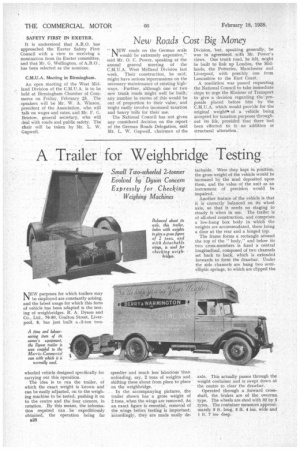A Trailer for Weighbridge Testing
Page 38

If you've noticed an error in this article please click here to report it so we can fix it.
NEW purposes for which trailers may be employed are constantly arising, and the latest usage for which this form of vehicle has been adapted is the testing of weighbridges. R. A. Dyson and Co., Ltd., 76-80, Grafton Street, Liverpool, 8, has just built a .2-ton two
wheeled vehicle designed specifically for carrying out this operation. .
The idea is to run the trailer, of which the exact weight is known and can be easily adjusted, on to the weighing machine to be tested, pushing it on to the centre and the four corners, in rotation. By this means, the information required can be expeditiously obtained, the operation being far B28 speedier and much less laborious than unloading, say, 2 tons of weights and . shifting these about from place to place on the weighbridge.
In the accompanying pictures, the trailer shown has a gross weight of 2 tons, when the wings are removed. As. an exact figure is essential, removal of the wings before testing is important, accordingly, they are made easily de tachable. Were they kept in position, the gross weight of the vehicle would be increased by the mud deposited upon them, and the value of the unit as an instrument of precision would be impaired.
Another feature of the vehicle is that it is correctly balanced on its wheel axis, so that it needs no staging to steady it when in use. The trailer is of all-steel construction, and comprises a low-hung box body in which the weights are accommodated, there being a door at the rear and a hinged top.
The frame forms a rectangle around the top of the " body," and below its two cross-members is fixed a central longitudinal, composed of two channels set back to back, which is extended forwards to form the drawbar. Under the side channels are hung two semi. elliptic springs, to which are clipped the axle. This actually passes through the weight container and is swept down at the centre to clear the drawbar.
Operated through a forward crossshaft, the brakes are of the overrun type. The wheels are shod with 32 by 5 tyres. The container measures approximately 5 ft. Icing, 3 ft. 4 ins, wide and I ft. 7 ins. deep.




















































































